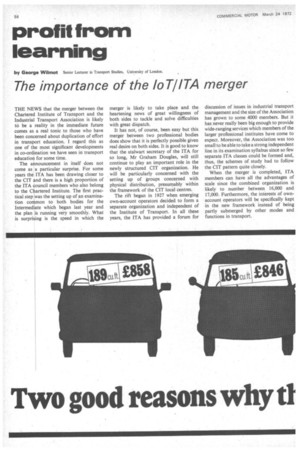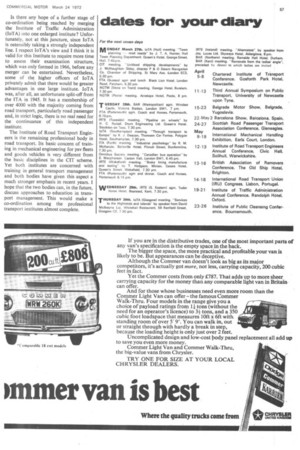profit from learning
Page 58

Page 59

If you've noticed an error in this article please click here to report it so we can fix it.
by George Wilmot Senior Lecturer in Transport Studies, University of London.
The importance of the loTIITA merger
THE NEWS that the merger between the Chartered Institute of Transport and the Industrial Transport Association is likely to be a reality in the immediate future comes as a real tonic to those who have been concerned about duplication of effort in transport education. I regard this as one of the most significant developments in co-ordination we have seen in transport education for some time.
The announcement in itself does not come as la particular surprise. For some years the; ITA has been drawing closer to • the CIT and there is a high proportion of the ITA council members who also belong to the Chartered Institute. The first practical step was the setting up of an examination common to both bodies for the Intermediate which began last year and the plan is running very smoothly. What is surprising is the speed in which the merger is likely to take place and the heartening news of great willingness of both sides to tackle and solve difficulties with great dispatch.
It has not, of course, been easy but this merger between two professional bodies does show that it is perfectly possible given real desire on both sides. It is good to know that the stalwart secretary of the ITA for so long, Mr Graham Douglas, will still continue to play an important role in the newly structured CIT organization. He will be particularly concerned with the setting up of groups concerned with physical distribution, presumably within the framework of the CIT local centres.
The rift began in 1927 when emerging own-account operators decided to form a separate organization and independent of the Institute of Transport. In all these years, the ITA has provided a forum for discussion of issues in industrial transport management and the size of the Association has grown to some 4000 members. But it has never really been big enough to provide wide-ranging services which members of the larger professional institutes have come to expect. Moreover, the Association was too small to be able to take a strong independent line in its examination syllabus since so few separate ITA classes could be formed and, thus, the schemes of study had to follow the CIT pattern quite closely.
When the merger is completed, ITA members can have all the advantages of scale since the combined organization is likely to number between 16,000 and 17,000. Furthermore, the interests of ownaccount operators will be specifically kept in the new framework instead of being partly submerged by other modes and functions in transport. Is there any hope of a further stage of co-ordination being reached by merging the Institute of Traffic Administration (IoTA) into one enlarged institute? Unfortunately, not at this juncture, since IoTA is ostensibly taking a strongly independent line. I respect IoTA's view and I think it is valid for this Institute to require more time to assess their examination structure, which was only formed in 1966, before any merger can be entertained. Nevertheless, some of the higher officers of IoTA privately admit that there would be greater advantages in one large institute. IoTA was, after all, an unfortunate split-off from the ITA in 1945. It has a membership of over 4000 with the majority coming from road transport, particularly road passenger and, in strict logic, there is no real need for the continuance of this independent institute.
The institute of Road Transport Engineers is the remaining professional body in road transport. Its basic concern of training in mechanical engineering for psv fleets and goods vehicles is very different from the basic disciplines in the CIT scheme. Yet both institutes are concerned with training in general transport management and both bodies have given this aspect a much stronger emphasis in recent years. I hope that the two bodies can, in the future, discuss approaches to education in transport management. This would make a co-ordination among the professional transport institutes almost complete.




















































































































































